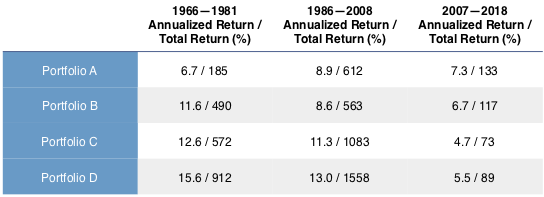You are told that you can invest in one of four boxes, each containing a passively managed portfolio, owning all the stocks in its defined universe. Because markets are efficient, each box has the same expected risk-adjusted return. The boxes are labeled A, B, C and D. To help you decide which box (investment strategy) to choose, the table above provides you with the following historical information, demonstrating that each of them endured long periods of relatively poor performance. Long periods of poor performance create greater risks for retirees.

Investing in an Uncertain World
Reviewing the table, you note that from 1966 through 1981, Portfolio A had by far the worst performance. Over that 16-year period, it even underperformed totally riskless one-month Treasury bills. In terms of total return, A underperformed B by 305 percent, C by 387 percent, and D by 727 percent.
We see a very different picture when we look at the 12-year period from 2007 through 2018, as A was the best performer. In terms of total returns, A outperformed B by 16 percent, C by 60 percent and D by 44 percent.
Turning to the period from 1986 through 2008, we find that in terms of total return, A outperformed B by 49 percent but underperformed C by 471 percent and D by 946 percent. No matter which strategy you choose, you run the risk of underperforming for a very long time by very wide margins.
Unfortunately, investors don’t have a crystal ball to tell us which of the four strategies will perform the best in the future. We only have particles of crystals, which are worthless for such purposes. So how do we choose, knowing that any of them might do very poorly for a long time?
Since all risky assets have similar expected returns, the way to minimize the idiosyncratic risk of each of the strategies is to diversify across all of them, avoiding putting all of our risk eggs in one risk basket. You don’t have to decide between A, B, C and D. You can invest in all of them, outfoxing the fox by refusing to play the game in that manner. Instead, create your own box E, diversifying your risks by investing some in each. In that way you reduce the risk of having all your eggs in the wrong basket while also eliminating the possibility of having them all in the “right” basket, which is known only in hindsight.
